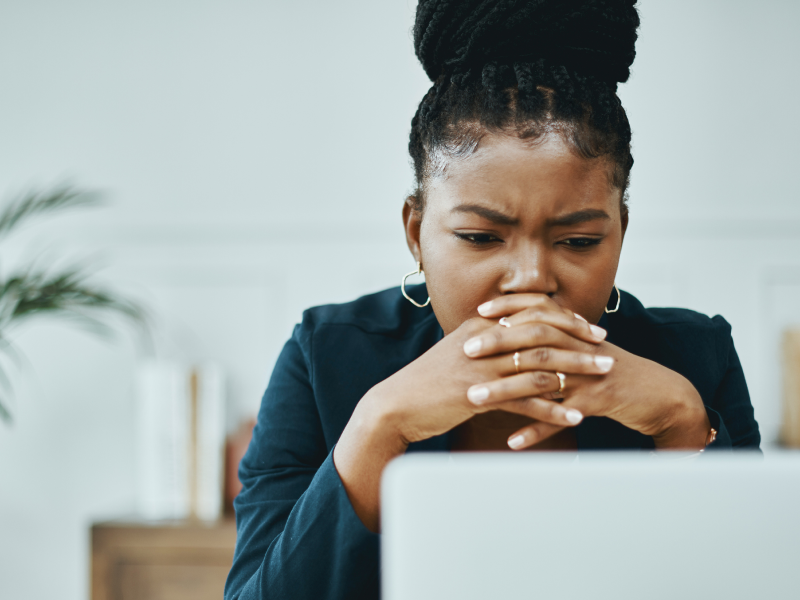
Table of Contents
Panic Attacks vs. Anxiety Attacks

Written By: Alex Bachert, MPH

Clinically Reviewed By: Dr. Don Gasparini
November 7, 2022
5 min.
Charlie Health reviews the differences between a panic attacks vs anxiety attack, as well as ways to cope.
Learn more about our Clinical Review Process
Table of Contents
You may have heard people use the terms “panic attack” and “anxiety attack” interchangeably, and that’s understandable. Both can be extremely disorientating and take a real toll on your mental health and wellbeing.
Although anxiety attack symptoms and panic attack symptoms share some similarities, it’s important to note that they are two separate conditions. Anxiety attacks tend to be less severe than panic attacks, but symptoms often last longer-potentially for days, weeks, or even months instead of minutes like with panic attacks. While panic attacks often seem to strike at random, symptoms of anxiety attacks frequently occur after a period of excessive worry or stress.
Below we break down the key differences between panic attacks and anxiety attacks, as well as the potential causes and treatments to help you prioritize your mental health.
What are panic attacks?
Panic attacks are sudden episodes of fear or anxiety that can strike at any time. They typically come on quickly, last for 5-20 minutes, and can occur when you least expect it-whether it’s during a meeting, while on a date, or even in your sleep.
One of the defining factors of panic attacks is that they cause a sudden wave of fear, discomfort, or lack of control-even when there’s no obvious signs of danger.
Common symptoms of panic attacks include:
- Racing heart
- Sweating
- Chills
- Trembling
- Chest or stomach pain
- Difficulty breathing
- Weakness or dizziness
- Numb or tingly hands
Not everyone who experiences a panic attack will develop panic disorder, but if you’ve had at least two panic attacks and spent at least one month worrying about another, then your attacks might qualify as panic disorder. Panic disorder is a type of anxiety disorder that affects just over 2% of adolescents in any given year. It’s more likely to affect females than males.
What are anxiety attacks?
Most of us get anxious from time to time, but for some people the stress or fear surrounding a specific event or problem can lead to an anxiety attack. The “Diagnostic and Statistical Manual of Mental Disorders, 5th edition” (DSM-5) doesn’t specifically reference anxiety attacks (although it does mention panic attacks), but it does link anxiety attacks to a variety of conditions such as generalized anxiety disorder, panic disorder, and social phobia.
Common symptoms of anxiety attacks are very similar to those of generalized anxiety disorder, including:
- Sweating
- Restlessness
- Dizziness
- Nausea
- Pins and needles
- Rapid breathing
- Headache
- Nervousness
Join the Charlie Health Library
Get mental health updates, research, insights, and resources directly to your inbox.
You can unsubscribe anytime.
Panic attack vs anxiety attack
Anxiety and panic attacks share some of the same symptoms, but there are notable differences between the two experiences.
- Panic attack symptoms are more severe: Both panic and anxiety attacks can cause fear, lightheadedness, and rapid breathing, but these sensations are usually more pronounced with panic attacks.
- Panic attacks typically start quicker and without warning or cause: Anxiety attacks are usually the result of a specific fear or concern. Panic attacks, however, occur without warning and sometimes even without a clear cause.
- Panic attackers are shorter in duration: Although panic attacks are more sudden and severe, they do tend to last for shorter periods of time. In general, panic attacks last for 5-20 minutes and typically peak in intensity around 10 minutes.

Causes and risk factors
We’re still not exactly sure what causes anxiety, but research suggests that genetic, environmental, and behavioral factors may all play a potential role in the development of panic or anxiety attacks.
Anxiety attacks, in particular, have been linked to environment and traumatic events during childhood. For example, individuals who grew up in an abusive household or witnessed traumatic events may face a higher risk of developing an anxiety disorder later in life. According to a 2018 study of more than 1,000 children who experienced trauma at some point, childhood trauma was associated with higher rates of psychiatric disorders-including anxiety disorders-during adulthood.
Anxiety disorders can be inherited so having a family history of anxiety or panic attacks may increase your risk of experiencing one yourself. Additionally, having a history of depression, an anxiety disorder, or other mental health conditions may make you more prone to a panic attack.
Do you need more support with
your mental health?
Charlie Health can help.
Diagnosis and treatment of a panic disorder or anxiety disorder
If you've lived through a panic attack or anxiety attack, know that there are resources and best practices to help you treat your symptoms, manage the condition, and improve your overall mental health.
- Do your research
Some people are embarrassed by having a panic attack or an anxiety attack so they keep the incidents to themselves. However, an untreated panic disorder can lead to anticipatory anxiety-extreme anxiety over the possibility of having an attack-as well as agoraphobia, an anxiety disorder that makes people afraid to be in places where a panic attack might occur. The more you understand your panic disorder and/or anxiety disorders, the better prepared you are to handle any future panic attacks. - Practice healthy habits
One way to help prevent anxiety or panic attacks is to identify and understand your triggers. By practicing healthy habits, you’ll be better prepared to avoid the circumstances that contribute to your stress and anxiety. For example, increasing exercise, reducing caffeine intake, and getting enough sleep are all helpful coping strategies. - Try psychotherapy
Cognitive behavioral therapy, or CBT, is one of the most commonly used forms of psychotherapy to treat panic disorder and anxiety conditions. CBT was designed to raise awareness about negative thinking patterns so that you’re better prepared to handle bouts of stress and fear. When practiced with a therapist, CBT can actually teach you how to process the feelings that happen before or during a panic attack, manage your panic disorder and/or anxiety disorder, and create a more peaceful relationship with your mental health.
Get help with Charlie Health
Charlie Health is committed to providing teens and adolescents with a proactive approach to mental wellness—all from the comfort of their home. Our intensive outpatient program connects you with other people experiencing panic attacks, anxiety attacks, or other types of mental health issues no matter where you live.
To learn more, visit our page about anxiety disorders in teens and young adults here.
References
https://www.charliehealth.com/post/how-to-keep-calm-with-panic-disorder
https://www.nimh.nih.gov/health/publications/panic-disorder-when-fear-overwhelms
https://www.ncbi.nlm.nih.gov/books/NBK519704/table/ch3.t10
https://www.charliehealth.com/post/generalized-anxiety-disorder-101
https://adaa.org/understanding-anxiety/panic-disorder-agoraphobia/symptoms
https://jamanetwork.com/journals/jamanetworkopen/fullarticle/2713038
https://www.ncbi.nlm.nih.gov/pmc/articles/PMC5573560/
https://my.clevelandclinic.org/health/diseases/4451-panic-attack-panic-disorder
https://pubmed.ncbi.nlm.nih.gov/34871964/
https://www.ncbi.nlm.nih.gov/pmc/articles/PMC2862829/
https://www.charliehealth.com/treatment-modalities/cognitive-behavioral-therapy





